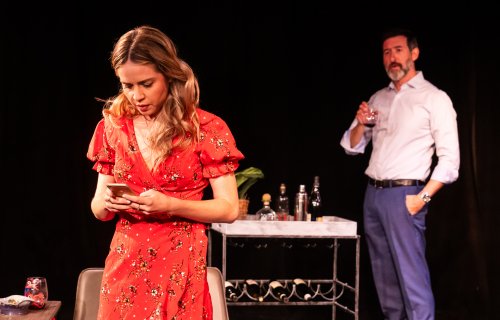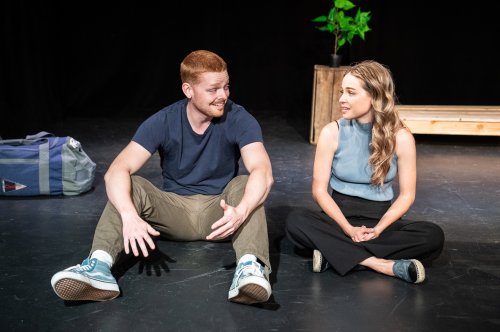In Search of Elaina
The play explores what happens when the life left behind catches up and crashes into the carefully laid-out landscape of now.

Aimée Fortier as Annette and Jamie Effros Charles in a scene from Kara Ayn Napolitano’s “In Search of Elaina” at The Steve & Marie Sgouros Theatre at The Players Theatre (Photo credit: Al Foote III)
There are times in one’s life when a connection with the past seems fresh and alive but not necessarily welcome. The memory of a comment, a look, or an event suddenly appears, unbidden, from deep within one’s core, impacting the emotional reality of the life being lived. The memory may not be accurate or even real in the flow of one’s life, but the truth doesn’t matter; only the feeling matters.
In Search of Elaina is a story by Kara Ayn Napolitano that digs into the weeds of a remembered past. It explores what happens when the life left behind catches up and crashes into the carefully laid-out landscape of now. Joy Donze skillfully directs a strong ensemble on this journey into the clash of the now with the memory of then.
There is a prologue with a disheveled young woman entering and slowly walking across the performance space immediately in front of the audience. She stares into the audience and, at one point, asks for money. She has the appearance of a homeless person, possibly a drug addict, panhandling to survive another day. She sits on a large box at the edge of the stage, where she will be on and off during the show.

Aimée Fortier as Annette and Rachel Griesinger Elaina in a scene from Kara Ayn Napolitano’s “In Search of Elaina” at The Steve & Marie Sgouros Theatre at The Players Theatre (Photo credit: Al Foote III)
The play opens with Charles (Jamie Effros) and Annette (Aimée Fortier) celebrating her job promotion in their apartment. Fortier gives a strong performance as both the adult Annette and the teenage version from her past, well-supported by Effros. As they prepare to go out to dinner, Annette receives a message from Tara (Alexandra Gellner), the sister of Johnny, her high school boyfriend of three years, telling her that he is dead and there is a memorial service happening the next night.
Annette reveals to Charles critical elements of her life before she moved away from a small town in California over ten years earlier. Throughout the conversation, details of her relationship with Johnny and Tara’s feelings towards Annette are laid out. Another important moment in this revelatory scene is when a spotlight illuminates the character encountered in the prologue. Annette stares at her in what is a memory vision and begins to type on her phone. The woman speaks, and in the ensuing dialogue, it is discovered that this is not the first time Annette has had this vision. The woman is not identified by name, but it is evident that she is Elaina, and the mystery of Annette’s relationship with her has begun. The scene ends with Charles and Annette deciding to go to California.
The next is a flashback to when Annette first met Elaina. This establishing scene reveals Annette’s real name is Annie Rae, and Tara’s animosity starts with a false rumor she told of Annie Rae having sex with one of her schoolmates. It also gives insight into the social settings with comments about the “mountain kids” and the kids from town, and establishes the identity of Elaina. Annie Rae will encounter Elaina’s memory several times during the play, each time adding more definition to the true reason for the trip. Rachel Griesinger solidly embodies Elaina as a teenager and later as an adult.

Greg Carere as Forest in a scene from Kara Ayn Napolitano’s “In Search of Elaina” at The Steve & Marie Sgouros Theatre at The Players Theatre (Photo credit: Al Foote III)
The action shifts to California with the introduction of the ensemble as they prepare for the memorial service. They represent the people Annette/Annie Rae left behind in her escape from the small-town culture for college and big-city lights. The ensemble brings their characters to life so thoroughly that there is no doubt the real people of the story are standing in the performance area.
The scene opens with Tara standing in front of a set loosely representing a house with a porch and window. She is smoking a cigarette and looking off into the distance. Timmy (Garrett Richmond), the younger brother of Tara and the dead Johnny, enters with a stack of pizza boxes in preparation for a party to follow the memorial service. This moment gives a solid definition of the character’s personalities as Tara snaps at Timmy, and he does his best to be supportive, but it is clear that his relationship with his sister is problematic.
Dustin (Lee Tyler) enters as the scene develops, followed shortly by Forest (Greg Carere). Dustin and Forest have been Johnny’s closest friends since childhood, and a deeper connection with Forest is suggested as the play unfolds. The interactions between these hometown characters provide the history of Annie Rae’s life in the town and shed light on things in her home life that contributed to her leaving after college and never wanting to return. However, it turns out that she returned at least once immediately after graduating from college.

Garrett Richmond as Timmy and Aimée Fortier as Annette in a scene from Kara Ayn Napolitano’s “In Search of Elaina” at The Steve & Marie Sgouros Theatre at The Players Theatre (Photo credit: Al Foote III)
Tara, Dustin, and Timmy show aspects of their personalities still stuck in adolescence. Forest is the only one of this hometown group that shows maturity and introspection. These distinctions are important in understanding what drives Annie Rae to find Elaina.
Donze’s direction skillfully weaves the story through the memory flashbacks to the adult introspections of the characters as they explore and uncover the feelings and attitudes that have long been hidden. The performances are engaging and believable, resulting in a surprising and solidly emotional ending. It is a play worth seeing.
Rachel Razor’s scenic design uses the limited area of the black box theater performance space, with props and settings suggesting a more detailed environment. The lighting design by Sasha Lysenko effectively gives definition to the action. Kara Ayn Napolitano’s costuming adds visual strength to the depiction of the characters. Robert Gonyo’s sound design completes the production team. Adam Garden effectively directs the brief fight sequence.
In Search of Elaina (through September 22, 2024)
Drift In Act Out in association with Platt Productions
The Steve & Marie Sgouros Theatre at The Players Theatre, 115 MacDougal Street, in Manhattan.
For tickets, visit http://www.insearchofelaina.com
Running time: two hours with one intermission






Leave a comment